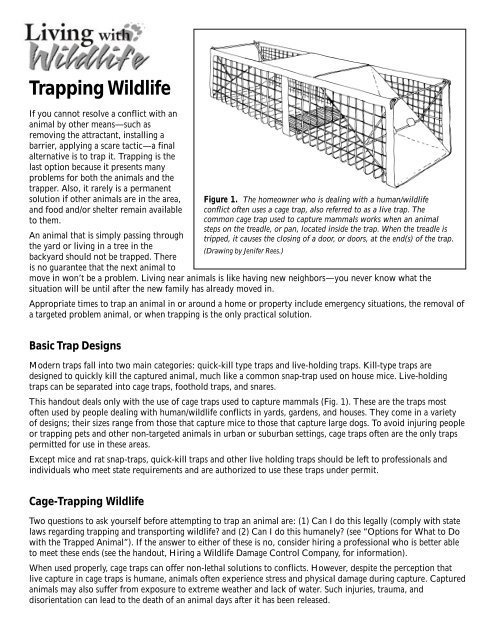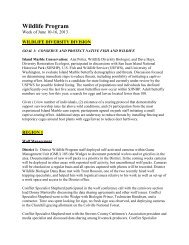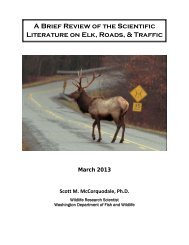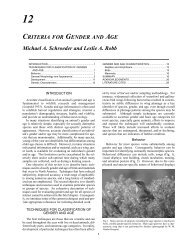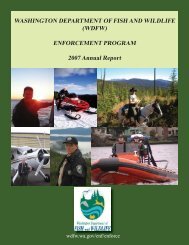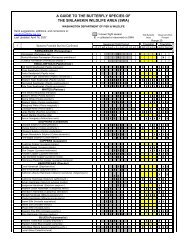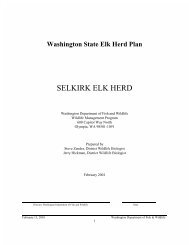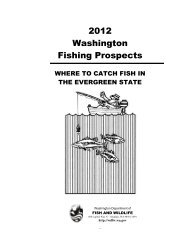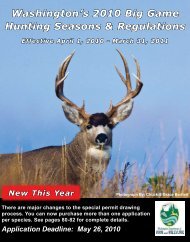Trapping Wildlife - Washington Department of Fish & Wildlife
Trapping Wildlife - Washington Department of Fish & Wildlife
Trapping Wildlife - Washington Department of Fish & Wildlife
Create successful ePaper yourself
Turn your PDF publications into a flip-book with our unique Google optimized e-Paper software.
<strong>Trapping</strong> <strong>Wildlife</strong><br />
If you cannot resolve a conflict with an<br />
animal by other means—such as<br />
removing the attractant, installing a<br />
barrier, applying a scare tactic—a final<br />
alternative is to trap it. <strong>Trapping</strong> is the<br />
last option because it presents many<br />
problems for both the animals and the<br />
trapper. Also, it rarely is a permanent<br />
solution if other animals are in the area,<br />
and food and/or shelter remain available<br />
to them.<br />
An animal that is simply passing through<br />
the yard or living in a tree in the<br />
backyard should not be trapped. There<br />
is no guarantee that the next animal to<br />
move in won’t be a problem. Living near animals is like having new neighbors—you never know what the<br />
situation will be until after the new family has already moved in.<br />
Appropriate times to trap an animal in or around a home or property include emergency situations, the removal <strong>of</strong><br />
a targeted problem animal, or when trapping is the only practical solution.<br />
Basic Trap Designs<br />
Modern traps fall into two main categories: quick-kill type traps and live-holding traps. Kill-type traps are<br />
designed to quickly kill the captured animal, much like a common snap-trap used on house mice. Live-holding<br />
traps can be separated into cage traps, foothold traps, and snares.<br />
This handout deals only with the use <strong>of</strong> cage traps used to capture mammals (Fig. 1). These are the traps most<br />
<strong>of</strong>ten used by people dealing with human/wildlife conflicts in yards, gardens, and houses. They come in a variety<br />
<strong>of</strong> designs; their sizes range from those that capture mice to those that capture large dogs. To avoid injuring people<br />
or trapping pets and other non-targeted animals in urban or suburban settings, cage traps <strong>of</strong>ten are the only traps<br />
permitted for use in these areas.<br />
Except mice and rat snap-traps, quick-kill traps and other live holding traps should be left to pr<strong>of</strong>essionals and<br />
individuals who meet state requirements and are authorized to use these traps under permit.<br />
Cage-<strong>Trapping</strong> <strong>Wildlife</strong><br />
Figure 1. The homeowner who is dealing with a human/wildlife<br />
conflict <strong>of</strong>ten uses a cage trap, also referred to as a live trap. The<br />
common cage trap used to capture mammals works when an animal<br />
steps on the treadle, or pan, located inside the trap. When the treadle is<br />
tripped, it causes the closing <strong>of</strong> a door, or doors, at the end(s) <strong>of</strong> the trap.<br />
(Drawing by Jenifer Rees.)<br />
Two questions to ask yourself before attempting to trap an animal are: (1) Can I do this legally (comply with state<br />
laws regarding trapping and transporting wildlife? and (2) Can I do this humanely? (see “Options for What to Do<br />
with the Trapped Animal”). If the answer to either <strong>of</strong> these is no, consider hiring a pr<strong>of</strong>essional who is better able<br />
to meet these ends (see the handout, Hiring a <strong>Wildlife</strong> Damage Control Company, for information).<br />
When used properly, cage traps can <strong>of</strong>fer non-lethal solutions to conflicts. However, despite the perception that<br />
live capture in cage traps is humane, animals <strong>of</strong>ten experience stress and physical damage during capture. Captured<br />
animals may also suffer from exposure to extreme weather and lack <strong>of</strong> water. Such injuries, trauma, and<br />
disorientation can lead to the death <strong>of</strong> an animal days after it has been released.
For these reasons, it is important that all precautions described throughout this handout are carefully followed.<br />
Cage traps can be purchased from hardware stores, farm supply centers, and over the Internet (search for “Live<br />
Traps” and “Cage Traps”). Some rental business and wildlife damage control companies rent them. Before using a<br />
trap, be sure it is clean, to prevent the animal coming in contact with or spreading potentially dangerous<br />
organisms. A dirty trap should be washed, disinfected with a bleach solution (1 part bleach to 9 parts <strong>of</strong> water and<br />
let it remain on for 20 minutes), and thoroughly rinsed. To protect yourself, always wear gloves when handling the<br />
trap.<br />
When Not to Trap<br />
Never trap an adult animal that is caring for dependent <strong>of</strong>fspring. Look and listen for young—even outside the<br />
animal’s known birthing season. If young are seen, heard, or you suspect they may be present, the most humane<br />
thing to do is to leave the family alone until they move on their own. Squirrels, raccoons, opossums, and other<br />
young mammals generally leave the nest area eight to ten weeks after being born.<br />
If the young need to be moved, you will want to get the mother to move them on her own using one <strong>of</strong> the<br />
techniques described in the handout, Evicting Animals from Buildings. Even in an emergency, females can <strong>of</strong>ten be<br />
persuaded to move their young, thus avoiding the need to trap families.<br />
When an adult animal is trapped, look for enlarged teats that are relatively free <strong>of</strong> hair, which indicate it is a<br />
female nursing young. (By standing the trap up on end you can usually observe the underneath side <strong>of</strong> the animal.)<br />
In such a case, release the female on site so she can tend to her young.<br />
Permanently separating the nursing female from her young would likely cause the <strong>of</strong>fspring to starve to death.<br />
Orphaned wildlife must be cared for by licensed pr<strong>of</strong>essionals. Do not attempt to care for the animals yourself.<br />
Not only could you further harm the animals, it is illegal for you to do so. Contact your local wildlife <strong>of</strong>fice for a<br />
current list <strong>of</strong> wildlife rehabilitators.<br />
Never trap an animal during poor weather with the intension <strong>of</strong> releasing it. Trapped animals expend energy that<br />
is normally used to cope with winter conditions and they may die soon after.<br />
What to Do with the Trapped Animal<br />
Before trapping an animal, you need to know what you are going to do with it after the animal has been captured.<br />
There are a variety <strong>of</strong> options:<br />
Option 1. Release the animal at the site <strong>of</strong> capture. With this option, an animal is trapped and released on site<br />
after its reentry into a structure is prevented by physical exclusion. (See the handout, Evicting Animals from<br />
Buildings, for exclusion techniques.)<br />
In such a case, the animal is evicted within its home range and because it is familiar with its surroundings, it can<br />
soon find suitable food and shelter. In the event young are present but were not noticed prior to trapping, allow<br />
the female back inside to tend to her dependent <strong>of</strong>fspring.<br />
A downside to this approach is the possibility that the animal may simply enter someone else’s attic, chimney, or<br />
similar place. Then, if someone else has to trap the animal, they will be dealing with a trap-smart animal, making<br />
its capture difficult.<br />
Option 2. Release the animal outside <strong>of</strong> its home range. The release <strong>of</strong> elk, bear, and other wildlife by<br />
pr<strong>of</strong>essional wildlife managers to reintroduce or augment populations is a proven and valid technique for wildlife<br />
management. However, releases <strong>of</strong> this kind should not be confused with moving problem wildlife, which may be<br />
illegal. For instance, in the State <strong>of</strong> <strong>Washington</strong>, it is unlawful to possess or transport live wildlife without a permit<br />
(WAC 232-12-064). This includes Eastern gray squirrels, Eastern cottontail rabbits, raccoons, and opossums.<br />
They are considered wildlife because they occur in <strong>Washington</strong> in a wild state—which includes neighborhood<br />
parks and backyards.<br />
Many times, not enough consideration is given to the impact <strong>of</strong> the capture and release process on the animal, or<br />
to the animal’s impact on the established wildlife populations at the release site. While wildlife released in a new
location is an option <strong>of</strong>ten preferred by well-meaning people opposed to killing animals, this may be at the<br />
expense <strong>of</strong> the released animal or the animals at the release site.<br />
Most biologists do not recommend releasing wildlife outside their home range for the following reasons:<br />
• Mortality rates increase when animals are subjected to stress and trauma associated with capture, handling,<br />
transport, and being released into an unfamiliar territory.<br />
• Animals that are released may harm or be harmed by resident animals (e.g., by territorial disputes, disease<br />
transmission, gene-pool disruptions, etc.).<br />
• The same (or a competing) species may already be overabundant in the area. Excess animals have to move or<br />
die.<br />
• Habitat conditions in the new area might not be suited to the animal being released.<br />
• Many animal species have strong homing instincts and, upon release, they begin traveling in the direction <strong>of</strong><br />
their capture sites, resulting in exposure to roads and other hazards.<br />
• Animals may cause problems for humans in the vicinity <strong>of</strong> the release site.<br />
Option 3. Euthanize the animal. The term euthanasia is derived from the Greek terms eu meaning good, and<br />
thanatos meaning death. A “good death” is one that occurs with minimal pain and distress.<br />
Whether to use euthanasia is a personal question and a matter <strong>of</strong> an individual’s perspective and values. Opinions<br />
also depend on what will be killed—people are <strong>of</strong>ten less upset if it’s a mouse or a snake that is killed, and more<br />
upset if it is a raccoon or a beaver.<br />
The most widely accepted—but still disputed—guidelines for euthanasia practices follow the standards set by the<br />
American Veterinarian Medical Association (AVMA), which include:<br />
• An injection <strong>of</strong> sodium pentobarbital or other pharmaceutical.<br />
• Carbon monoxide (CO) or carbon dioxide (CO2) supplied to a chamber from a compressed gas cylinder<br />
(small and medium sized animals).<br />
• A gun shot to the head (small and medium sized animals. (Check local firearm ordinances).<br />
• Stunning, followed by decapitation (amphibians, reptiles, and birds only).<br />
• Cervical dislocation by stretching the animal so the neck is hyper-extended to separate the first vertebrae<br />
from the skull (birds, rabbits, and small rodents only).<br />
Unfortunately, the majority <strong>of</strong> the above agents <strong>of</strong> euthanasia require training and care to administer. In addition,<br />
most are not available to, or do not appeal to, the do-it-yourselfer.<br />
Care should always be taken to guarantee that the animal is euthanized humanely. If it cannot, or you do not have<br />
the necessary training, an alternative would be to contact your local wildlife damage control company,<br />
veterinarian, or animal shelter. They may euthanize the animal for a fee.<br />
While drowning and freezing have long been considered a humane way to deal with problem wildlife, animal<br />
experts no longer generally accept these techniques, and they are not considered humane by the AVMA standards.<br />
While shooting an animal may sound extreme, in many cases it is the best available method because <strong>of</strong> its<br />
quickness, and it may cause the least amount <strong>of</strong> stress and pain to the animal. If shooting is used, the operator and<br />
firearm must be capable <strong>of</strong> producing a quick death. To calm down an active animal, the trap can be covered with<br />
a dark towel or other cover.<br />
Depending on the species and size <strong>of</strong> the animal, a .22caliber rifle or revolver, or a high-velocity pellet gun should<br />
be used. A pellet gun fired to the head is capable <strong>of</strong> quickly killing tree squirrels, rabbits, and similar-size<br />
mammals. Local laws and regulations regarding the discharge <strong>of</strong> firearms must be followed. See Step 4 below for<br />
information on how to handle the dead animal.<br />
Note: In order to properly check an animal for possible rabies, the animal must not be shot in the head; instead,<br />
aim for the lung area directly behind the front shoulder.
Human psychological responses to euthanasia <strong>of</strong> animals need to be considered, with grief at the loss <strong>of</strong> life as the<br />
most common reaction. People who have to euthanize animals, especially under public pressure to save the animals<br />
rather than destroy them, can experience extreme distress and anxiety.<br />
Cage-<strong>Trapping</strong> <strong>Wildlife</strong>: Steps to Take<br />
If an animal needs to be trapped and you are uncomfortable or have no interest in doing the work yourself, contact<br />
a wildlife damage control company. In the wildlife damage control industry, private companies made up <strong>of</strong> one or<br />
more people <strong>of</strong>fer a variety <strong>of</strong> services, including trapping.<br />
Experienced trappers know the behavior <strong>of</strong> each species and the methods required to trap them. They also<br />
recognize signs <strong>of</strong> diseases and nursing females. Often their solution to a conflict will involve setting several cage<br />
traps to make sure the entire family <strong>of</strong> animals is caught—or as many as possible at one time. Multiple traps are<br />
not something most homeowners have on hand. (See the handout, Hiring a <strong>Wildlife</strong> Damage Control Company,<br />
for more information.)<br />
Note: Persons working at state wildlife <strong>of</strong>fices do not provide trapping services, but they can provide names <strong>of</strong><br />
individuals and companies that do.<br />
If you are somewhat knowledgeable about wildlife, have identified the species <strong>of</strong> animal to be trapped, and feel<br />
you can handle the situation in a humane and legal way, follow the steps below.<br />
See Table 1 for detailed trapping information for individual species.<br />
Step 1. Develop a Plan that Includes Options<br />
• Contact your local wildlife <strong>of</strong>fice and municipality for current information on trapping restrictions (types <strong>of</strong><br />
traps to be used, requirements for euthanization, species <strong>of</strong> biological concern in the area) and any required<br />
authorization.<br />
• Decide if the animal will be released on site, euthanized, or moved somewhere else by someone who has a<br />
permit to transport it.<br />
• If it is to be released on site, be ready to make all necessary construction repairs to ensure that the animal<br />
will not reenter the structure after being released.<br />
• If the animal is to be euthanized, decide who, and if necessary, how it will be done. Note: Have a backup<br />
plan in case your original plan changes.<br />
Step 2. Set the Trap<br />
• Set the cage trap as near to the den as possible, in the animal’s pathway, or in the area <strong>of</strong> damage (see Table 1<br />
for specific recommendations). When locating the trap, consider the possibility <strong>of</strong> young children<br />
approaching the trapped animal, theft <strong>of</strong> the trap, or damage to the trap by vandals.<br />
• If setting a trap on concrete or another hard surface, place the trap on plywood or some other protective<br />
surface to prevent the animal from damaging its paws when trying to dig its way out. To prevent raccoons<br />
and opossums from toppling the trap, make sure the protective material extends out from the trap at least 8<br />
inches and locate the trap away from shrubs or other objects that they could grab.<br />
• A captured animal <strong>of</strong>ten defecates in a trap. If the trap is set outdoors, biological risk is minimal but still real.<br />
Refrain from setting a trap near a shallow well, garden, playpen, or where a dog is tethered. Traps set inside<br />
the living area <strong>of</strong> the house should be placed on top <strong>of</strong> at least ten sheets <strong>of</strong> newspaper.<br />
• Place a tennis ball in the trap to give a large animal a way to release energy and frustration; a piece <strong>of</strong> wood<br />
will provide a small animal something to chew.<br />
• Anchor the trap so it won’t tip or misfire when the animal enters—an animal will not enter a tipsy trap, and<br />
misfires teach it not to try and enter again. Anchor the trap with a cinder block or other heavy object placed<br />
on top. You can also pound rebar stakes into the ground at the corners, or wire or clamp the trap to a stable<br />
object.
• Set the trap and then trip it several times to be sure the cage is steady and functioning properly. Trip the trap<br />
by using a pen or pencil, sticking an end through the side <strong>of</strong> the cage and pushing down on the treadle. If the<br />
doors do not work fast enough, place small stones or other weights on top <strong>of</strong> the door to make it drop faster.<br />
• Use plenty <strong>of</strong> the suggested bait so it will be seen and its odor released into the air (see Table 1 and<br />
“Capturing a Wary or Trap Smart Animal” for detailed information regarding baiting).<br />
Step 3. Monitor the Trap and Animal<br />
• Be “on call” the entire time a trap is set.<br />
• A trap set for a nocturnal animal should be set at or near dusk. The unset trap should be closed at dawn to<br />
avoid trapping a non-target animal during the day. Reverse this procedure when attempting to capture a<br />
diurnal (active during daylight) animal. Change the trap location or try different bait if it doesn’t produce a<br />
catch within three days.<br />
• When an animal is captured, move the trap to a quiet, protected spot and cover it with a tarp until time <strong>of</strong><br />
release or euthanasia. A captured animal should not remain in the trap longer than necessary. Note: In<br />
summer, a trap set where the sun can beat down on it can cause the animal to dehydrate rapidly, suffer a heat<br />
stroke, or die.<br />
• If the captured animal appears injured or sick (i.e., having a discharge from eyes or nose, or a dull, sparse<br />
coat or scabby skin) and you don’t want to euthanize it or have it euthanized, contact a wildlife rehabilitator<br />
(see <strong>Wildlife</strong> Rehabilitators and <strong>Wildlife</strong> Rehabilitation). Note: Most vets and animal shelters won’t accept a<br />
sick wild animal because <strong>of</strong> their concern for the spread <strong>of</strong> disease.<br />
Step 4. Remove the Animal from the Trap<br />
• Release nocturnal animals at night and diurnal species during daylight.<br />
• Point the opening <strong>of</strong> the trap toward escape cover, so the animal can see and move toward it. Stand at the<br />
opposite end <strong>of</strong> the trap, open the door, and tap the trap with your foot. If the animal is reluctant to leave,<br />
try placing the open trap on its side and moving away from the trap.<br />
• When releasing an animal that <strong>of</strong>fers the potential <strong>of</strong> a bite or a spray, attach a long string to the door <strong>of</strong> the<br />
trap prior to setting it, so the door can later be opened from a distance. Place the trap under the driver’s-side<br />
door <strong>of</strong> a truck, or a window on a house, lean out the window, and hold the door open with the string until<br />
the animal exits. Note: Skunks and opossums <strong>of</strong>ten take their time when leaving a cage trap.<br />
• The carcasses <strong>of</strong> euthanized animals must be disposed <strong>of</strong> properly. To dispose <strong>of</strong> an animal on-site, the<br />
carcass must be covered by at least 2 feet <strong>of</strong> soil and located at least 200 feet from any groundwater well that<br />
is used to supply drinking water. Cover the burial hole with rocks or strong wire screening to help prevent<br />
animals digging into it. Sprinkling a layer <strong>of</strong> garden lime on the carcass will also help reduce the odor, which<br />
attracts digging animals. If it is not feasible to dispose <strong>of</strong> a carcass on-site, contact a local veterinarian or<br />
wildlife damage control company for assistance with disposal. Animal carcasses should never be handled with<br />
bare hands.<br />
Step 5. Follow up<br />
• A trap that contained a sick animal should be washed, disinfected with a bleach solution (1 part bleach to 9<br />
parts <strong>of</strong> water and let it remain on for 20 minutes), and thoroughly rinsed after each capture so as to stop the<br />
spread <strong>of</strong> any potential disease.<br />
• Immediately complete all repair work necessary to prevent another conflict.
Capturing a Wary or Trap-Smart Animal<br />
Tips from trappers who capture wary or trap-smart animals include:<br />
Entice an animal into a trap by sprinkling bits <strong>of</strong> bait leading from<br />
the travel route <strong>of</strong> the animal to the trap door and into the trap. To<br />
prevent filling the animal up with food before it enters the trap, use<br />
a small amount <strong>of</strong> bait, every 6 to 12 inches.<br />
Funnel the animal into the trap using the funnel method (Fig. 2).<br />
Wire bait to the back <strong>of</strong> a single-door trap to force the animal to<br />
step on the trip pan while reaching forward to get the bait. Wrap<br />
the back <strong>of</strong> the cage with small-mesh wire screen so the animal<br />
can’t reach through the larger mesh wire to get the bait.<br />
Put out an unset trap with the door(s) wired open for several nights.<br />
Offer some bait outside the trap the first night, at the trap’s<br />
entrance the second night, and then inside the trap the third<br />
night—still without setting it. On the fourth night, place the bait<br />
inside and set the trap with an unwired door(s).<br />
Camouflage the trap by covering the bottom with soil, leaf litter,<br />
grass clippings, or similar material, using enough to just hide the<br />
treadle. (A different material placed on the bottom <strong>of</strong> the same trap<br />
can sometimes be used to catch an animal a second time.) Also,<br />
place a few things like branches, boughs, or boards over or leaning<br />
Figure 2. Place 2 x 6 inch boards, cinder<br />
blocks, or a similar barricade in such a way<br />
as to funnel raccoons, opossums, skunks, or<br />
other animals into a trap.<br />
(Drawing by Jenifer Rees.)<br />
against the trap to cover any glare and break up the outline <strong>of</strong> the trap. Make sure this camouflage does not<br />
interfere with the operation <strong>of</strong> the trap.<br />
To help make the trap as “invisible” as possible, reduce the high glare <strong>of</strong> the cage steel with some earth tone paint.<br />
To deal with the animal’s sensitive nose, wear old gloves when preparing the trap, and do not walk or linger around<br />
the site any longer than necessary. New cage-traps may need to be washed with water and vinegar to remove oils.<br />
Before leaving, mist the area around the trap with a spray bottle containing water and fir needles, or other local<br />
aromatic vegetation.<br />
When using a two-door trap, securely fasten one door down to prevent an animal from backing out and getting<br />
away. With two-door traps, the trip pan to release the doors is in the middle <strong>of</strong> the trap, and only allows the animal<br />
to get halfway into the trap before it closes. The door may land on the back or tail <strong>of</strong> a large raccoon and not close<br />
completely.<br />
To prevent this, use a trap with only one door, use a larger two-door trap, or secure one <strong>of</strong> the doors down so only<br />
one is in operation. This allows the bait to be placed in back <strong>of</strong> the trap, forcing the animal to go farther into it. You<br />
can also place a wedge-shaped piece <strong>of</strong> wood under the trip pan on the open-door side <strong>of</strong> the trap. This allows the<br />
animal to step on the front side, without anything happening. As it steps on the back side <strong>of</strong> the pan, the door<br />
closes.<br />
To prevent capturing birds, mix peanut butter/oatmeal/sunflower seeds as bait. Place this on the inside ro<strong>of</strong> <strong>of</strong> the<br />
trap above the pan. Spreading the bait above the trip pan keeps it out <strong>of</strong> sight <strong>of</strong> birds and causes the animal to<br />
stand on the pan to taste the bait. An option is to smear peanut butter on a pine cone or other inedible object—<br />
not bread, which is another bird attractant—and place it on the bottom <strong>of</strong> the trap.<br />
To prevent catching a domestic cat or dog, don’t bait with meat or fish products. However, if the target animal has<br />
been eating pet food, use pet food as bait.<br />
To prevent bait from getting wet, place it in a light-colored, covered container with plenty <strong>of</strong> holes punched in the<br />
side.
Table 1. Cage-trapping specifications.<br />
<strong>Wildlife</strong><br />
Species<br />
Badger<br />
Bat<br />
Note: The below are minimum height, width, and length measurements.<br />
Single-door type,<br />
10 x 12 x 42 in.<br />
Chicken and<br />
attractors such as<br />
feathers and eggshells,<br />
cotton balls, or<br />
marshmallows.<br />
Due to the strength and aggressiveness <strong>of</strong> badgers, it is<br />
recommended that a pr<strong>of</strong>essional trapper trap them.<br />
Contact your local wildlife <strong>of</strong>fice for release sites.<br />
<strong>Trapping</strong> bats is not recommended. Traps can be fatal to bats if left unattended, or if they become<br />
overcrowded. In addition, bats have excellent homing instincts, making moving bats unlikely to succeed.<br />
Instead, use the exclusion methods described under “Bats Roosting in Buildings” in the handout titled<br />
Bats.<br />
Beaver Beaver Hancock or<br />
Bailey suitcase-type<br />
trap<br />
Bobcat<br />
Cat<br />
(domestic cat)<br />
Coyote<br />
Chipmunk<br />
Trap type, size<br />
(height, width, length)<br />
Single-door type,<br />
15 x 20 x 42 in.<br />
Single-door type,<br />
11 x 11 x 32 in.<br />
Double-door traps<br />
should be 42 in. long<br />
Single-door type,<br />
20 x 26 x 48 in.<br />
Single- or doubledoor<br />
type,<br />
5 x 5 x 16 in.<br />
Bait Notes<br />
Freshly cut tree<br />
sprouts or branches,<br />
commercial scents and<br />
lures.<br />
Poultry or rabbit<br />
carcass and feathers<br />
for a sight attractor.<br />
Moist or dry cat food,<br />
tuna.<br />
Sight attractors like<br />
chicken feathers,<br />
eggshells, cotton<br />
balls. An auditory lure<br />
that “squeals” can be<br />
effective. Wrap it in<br />
paper towels and a<br />
baggie to muffle the<br />
volume.<br />
Unroasted peanuts,<br />
sunflower seeds,<br />
grain, popcorn, apple<br />
slices.<br />
Due to the weight and dangers associated with suitcase<br />
traps, it is recommended that only people experienced<br />
with these traps use them. Some success has also come<br />
from using a 4 foot long cage trap set right at the<br />
water’s edge next to the beaver slide.<br />
Set the trap in the vicinity <strong>of</strong> an animal kill or a travel<br />
way to and from cover. Use brush or grass on the top<br />
and sides <strong>of</strong> the trap to give the appearance <strong>of</strong> a natural<br />
“cubby” or a recess in a rock outcrop or in brush.<br />
Cover the cage bottom with soil. (See “Capturing a<br />
Wary or Trap-Smart Animal” for detailed information.)<br />
Set the trap in the area being frequented by the<br />
particular cat. Pre-baiting and laying a towel or<br />
something over the floor may be necessary. (See<br />
“Capturing a Wary or Trap-Smart Animal” for detailed<br />
information.)<br />
Note: A cat that is assumed to be a docile pet can turn<br />
into a hostile animal when captured. Handle a caged<br />
domestic cat with the same respect you would any wild<br />
animal.<br />
Cage traps are rarely effective at capturing healthy adult<br />
coyotes and most effective at capturing young or sick<br />
coyotes living in urban areas or entering a chicken coop<br />
or other holding area for pets, livestock, or birds. The<br />
trap should be thoroughly concealed with a tarp or<br />
other material, and extra precautions need to be taken<br />
to eliminate human scent from the area <strong>of</strong> the trap. (See<br />
“Capturing a Wary or Trap-Smart Animal” for detailed<br />
information.)<br />
Place the trap where the chipmunk is active. Place a few<br />
sunflower seeds in front <strong>of</strong> the trap entrance.
<strong>Wildlife</strong><br />
Species<br />
Dog<br />
(domestic dog)<br />
Fox<br />
(red fox)<br />
Ground<br />
squirrel<br />
Marmot<br />
(yellow-bellied<br />
marmot)<br />
Mice<br />
Mink<br />
Mole<br />
Mountain<br />
beaver<br />
Trap type, size<br />
(height, width, length)<br />
Single-door type, 12 x<br />
12 x 36 to 20 x 28 x<br />
72 in., depending on<br />
size <strong>of</strong> dog<br />
Single-door type, 15 x<br />
15 x 48 in.<br />
Single-door type, 5 x<br />
5 x 15 in. to 7 x 7 x<br />
24 in., longer if a<br />
double-door trap is<br />
used<br />
Single-door type,<br />
12 x 12 x 36 in.,<br />
longer if a doubledoor<br />
trap is used<br />
Single or double-door<br />
type, 3 x 3 x 10 in.<br />
Single-door type, 7 x<br />
7 x 17 in., longer if a<br />
double-door trap is<br />
used<br />
Single-door type,<br />
7 x 7 x 17 in.<br />
Bait Notes<br />
Moist dog food. Set the trap in the area being frequented by the<br />
particular dog. Note: A dog that is assumed to be a<br />
docile pet can turn into a hostile animal when captured.<br />
Handle a caged dog with the same respect you would<br />
any wild animal.<br />
Tainted meat, eggs<br />
placed in a nest,<br />
marshmallows, cotton<br />
balls (they resemble<br />
eggs and have eye<br />
appeal).<br />
Peanut butter, oats,<br />
barley, fresh fruit,<br />
vegetables, greens.<br />
Peanut butter, oats,<br />
barley, fresh fruit,<br />
vegetables, greens.<br />
Foxes are long-bodied animals, so the trap must be<br />
long. Take precautions to eliminate human scent from<br />
the trap and the area around the trap. Place bait in a<br />
hole dug under the rear <strong>of</strong> the trap. Cover all sides <strong>of</strong><br />
the trap with a tarp or other material. Sift dirt onto the<br />
bottom <strong>of</strong> the cage to cover the wire bottom. (See<br />
“Capturing a Wary or Trap-Smart Animal” for detailed<br />
information.)<br />
Set the trap near an active burrow with signs <strong>of</strong> recent<br />
diggings. Placing guide logs on either side <strong>of</strong> the path<br />
between the burrow opening and the trap will help<br />
funnel the animal into the trap. Cover the floor <strong>of</strong> the<br />
trap with soil and leave the bait highly visible. Cover<br />
the trap with a tarp to conceal the trap and provide an<br />
enticing nook for the animal to enter. (See “Capturing a<br />
Wary or Trap-Smart Animal” for detailed information.)<br />
See Ground squirrels.<br />
Peanut butter, grain. Locate trap along walls, behind objects, in dark corners,<br />
and where runways narrow, causing mice to be funneled<br />
into a limited area. Mice travel along walls. Mice are<br />
easily caught in “snap traps.”<br />
See the handout, titled Mice, for additional<br />
information.<br />
Cheese or fresh<br />
bloody meat such as<br />
chicken or rabbit; use<br />
sight attractors like<br />
feathers or fur.<br />
See “Lethal Control” in the handout, titled Moles, for information.<br />
Piece <strong>of</strong> apple, sweet<br />
potato, or whatever is<br />
being eaten in the<br />
area.<br />
Wrap the cage trap in something dark; mink like to<br />
investigate dark holes. Set the trap in the animal’s line<br />
<strong>of</strong> travel.<br />
Set trap directly in the entrance <strong>of</strong> an active tunnel.<br />
Alternatively, place a plastic laundry basket over the<br />
hole and cut out an opening just large enough to insert<br />
the door <strong>of</strong> a trap into the basket cut-out. The<br />
mountain beaver will search for an opening to go<br />
through and enter the trap. Stake the basket down so it<br />
cannot be moved. Mountain beavers are very prone to<br />
hypothermia, so wrap the trap with black plastic or<br />
burlap and cover it with soil. Trap when the weather is<br />
mild and check the trap early in the morning.
<strong>Wildlife</strong><br />
Species<br />
Muskrat<br />
Nutria<br />
Opossum<br />
Porcupine<br />
Rabbit and<br />
Hares<br />
Raccoon<br />
Rats<br />
River otter<br />
Trap type, size<br />
(height, width, length)<br />
Single-door type,<br />
6 x 6 x 20 in.,<br />
longer for doubledoor<br />
traps<br />
Single-door type,<br />
9 x 9 x 45 in.<br />
Single- or doubledoor<br />
type, 11 x 11 x<br />
36 in<br />
Double-door type,<br />
10 x 12 x 42 x in.<br />
Single- or doubledoor<br />
type, 9 x 9 x 26<br />
in.<br />
Single-door type,<br />
10 x 12 x 42 in.<br />
Single- or doubledoor<br />
type, 5 x 5 x 18<br />
in.<br />
Single-door type,<br />
10 x 12 x 42 in.<br />
larger, longer if a<br />
double-door trap is<br />
used<br />
Bait Notes<br />
Corn, carrot greens,<br />
sweet apples, cattail<br />
roots.<br />
Cantaloupe rind, ripe<br />
bananas, sweet<br />
potatoes.<br />
Dry or canned pet<br />
food, sardines, old<br />
meat, chicken entrails,<br />
bacon, fish, apples.<br />
A salt-soaked cloth,<br />
sponge, or piece <strong>of</strong><br />
wood, also water<br />
s<strong>of</strong>tener tablets, sweet<br />
potatoes, apples,<br />
roasted peanuts.<br />
Fresh vegetables in<br />
summer; apples,<br />
carrots, or bread in<br />
winter.<br />
<strong>Fish</strong>-flavored cat<br />
food, corn, ripe<br />
bananas, bacon,<br />
sardines, peanut<br />
butter, jelly<br />
marshmallows,<br />
(resemble eggs and<br />
have eye appeal).<br />
Place the trap just outside the burrow and partially in<br />
the water, taking every precaution that the captured<br />
muskrat will not be under water and will be able to<br />
breathe. Conceal the cage trap well with grass or leaves.<br />
A short line <strong>of</strong> bait leading to the entrance <strong>of</strong> a trap will<br />
increase capture success.<br />
Place the trap along an active trail or where nutria are<br />
seen. A short line <strong>of</strong> bait leading to the entrance <strong>of</strong> the<br />
trap will increase capture success. A trap placed on a<br />
floating raft will effectively catch nutria, but pre-baiting<br />
is necessary (see “Capturing a Wary or Trap-Smart<br />
Animal”).<br />
Place the trap where the animal, or evidence <strong>of</strong> the<br />
animal has been seen, or at its den entrance.<br />
Place the trap in the vicinity <strong>of</strong> damage or at the den<br />
entrance.<br />
To lure the porcupine, blend a cup <strong>of</strong> raw sweet<br />
potatoes and an apple, and dribble the puréed mixture<br />
at the opening <strong>of</strong> a single-door live trap.<br />
Place the trap near cover where rabbits feed or rest, or<br />
where they gain entry under a fence. Place some bait<br />
just outside the trap and spray the inside with apple<br />
juice to increase effectiveness. To capture hares<br />
(jackrabbits) in open terrain, use a double-door trap<br />
with weighted doors to prevent escape. It is best to use<br />
a larger trap than used on rabbits.<br />
Place the trap where the animal, or evidence <strong>of</strong> the<br />
animal has been seen, or at its den entrance. (See<br />
“Capturing a Wary or Trap-Smart Animal” for<br />
additional information.)<br />
Peanut butter, grain. Locate trap along walls, behind objects, in dark corners,<br />
and where runways narrow, causing rats to be funneled<br />
into a limited area. Rats travel along walls. Rats can be<br />
caught in “snap traps.” See the handout, titled Rats, for<br />
additional information.<br />
Fresh fish. Cover the bottom <strong>of</strong> the trap with sand. (See<br />
“Capturing a Wary or Trap-Smart Animal” for detailed<br />
information.) River otters may be trapped in suitcase<br />
type traps used to capture beavers. Modify the sides so<br />
the otters can’t escape.
<strong>Wildlife</strong><br />
Species<br />
Skunk<br />
(spotted skunk)<br />
Skunk<br />
(striped skunk)<br />
Squirrel<br />
(Eastern gray and<br />
fox squirrel)<br />
Squirrel<br />
(Douglas and<br />
flying squirrel)<br />
Weasel<br />
(long-tailed<br />
weasel)<br />
Weasel<br />
(short-tailed<br />
weasel)<br />
Trap type, size<br />
(height, width, length)<br />
Single-door type, 7 x<br />
7 x 20 in.<br />
Single-door type,<br />
10 x 10 x 24 in.<br />
Single- or doubledoor<br />
type, 6 x 6 x 24<br />
in., longer for doubledoor<br />
traps<br />
Single- or doubledoor<br />
type, 5 x 5 x 18<br />
in.<br />
Single- or doubledoor<br />
type, 5 x 5 x 24<br />
in.<br />
Single- or doubledoor<br />
type, 5 x 5 x 18<br />
in.<br />
Bait Notes<br />
Small marshmallows<br />
(resemble eggs),<br />
tainted meat, sardines,<br />
bacon, canned fish.<br />
Peanut butter,<br />
bananas, honey, or<br />
molasses spread on a<br />
piece <strong>of</strong> bread or<br />
dried fruit; also<br />
yogurt, cheese, raw<br />
egg (trail some<br />
through the trap and<br />
leave the rest in the<br />
back <strong>of</strong> the trap.<br />
Peanut butter, nuts,<br />
corn, sunflower seed,<br />
popcorn, bread<br />
Apples, sunflower<br />
seeds, roasted<br />
peanuts.<br />
<strong>Fish</strong>, fresh chicken<br />
liver, chicken entrails.<br />
<strong>Fish</strong>, fresh chicken<br />
liver, chicken entrails.<br />
See below.<br />
Place the trap along a travel route or immediately<br />
outside the den entrance, using the funnel method (Fig.<br />
2). Alternatively, place a plastic laundry basket over the<br />
hole and cut out an opening just large enough to insert<br />
the door <strong>of</strong> a trap into the basket cut-out. The skunk<br />
will search for an opening to go through and go into<br />
the trap. Stake the basket down so it cannot be moved.<br />
Box traps designed specifically for trapping skunks are<br />
available, or a cover can be made out <strong>of</strong> a dark-colored<br />
blanket, plywood, or cardboard fastened with bungee<br />
cords. If a skunk is accidentally caught, use a long stick<br />
or other device to slowly cover the trap with a towel or<br />
blanket before moving it. Avoid sudden movements or<br />
loud noises that may frighten the skunk.<br />
A squirrel may not find a trap set in the dark, or it may<br />
bump the trap, causing it to close prematurely. A trap<br />
set on the ro<strong>of</strong> is safe from theft, children, and pets,<br />
and <strong>of</strong>fers a better chance for catching the squirrel. If<br />
possible, find a window adjacent to a ro<strong>of</strong> that the<br />
squirrel is using and you won’t need a ladder. To<br />
prevent catching birds, see “Capturing a Wary or Trap-<br />
Smart Animal.”<br />
For Douglas squirrels, see above. For flying squirrels,<br />
set the trap inside a structure and near the animal’s<br />
point <strong>of</strong> entry.<br />
Set the trap in an old brush pile, or under an<br />
outbuilding or fence, since the weasel is likely to<br />
investigate any small covered area.<br />
Set the trap in an old brush pile, or under an<br />
outbuilding or fence, since the weasel is likely to<br />
investigate any small covered area.<br />
Adapted from “Living with <strong>Wildlife</strong> in the Pacific Northwest” (see http://wdfw.wa.gov/wlm/living.htm)<br />
Written by: Russell Link, WDFW Urban <strong>Wildlife</strong> Biologist, Linkrel@dfw.wa.gov<br />
Design and layout: Peggy Ushak<strong>of</strong>f, ITT2<br />
Copyright 2005 by the <strong>Washington</strong> <strong>Department</strong> <strong>of</strong> <strong>Fish</strong> and <strong>Wildlife</strong>.<br />
This program receives Federal financial assistance from the U.S. <strong>Fish</strong> and <strong>Wildlife</strong> Service. It is the policy <strong>of</strong><br />
the <strong>Washington</strong> State <strong>Department</strong> <strong>of</strong> <strong>Fish</strong> and <strong>Wildlife</strong> (WDFW) to adhere to the following: Title VI <strong>of</strong> the<br />
Civil Rights Act <strong>of</strong> 1964, Section 504 <strong>of</strong> the Rehabilitation Act <strong>of</strong> 1973, Title II <strong>of</strong> the Americans with<br />
Disabilities Act <strong>of</strong> 1990, the Age Discrimination Act <strong>of</strong> 1975, and Title IX <strong>of</strong> the Education Amendments <strong>of</strong><br />
1972. The U.S. <strong>Department</strong> <strong>of</strong> the Interior and its bureaus prohibit discrimination on the bases <strong>of</strong> race, color,<br />
national origin, age, disability and sex (in educational programs). If you believe that you have been<br />
discriminated against in any program, activity or facility, please contact the WDFW ADA Coordinator at 600<br />
Capitol Way North, Olympia, <strong>Washington</strong> 98501- 1091


